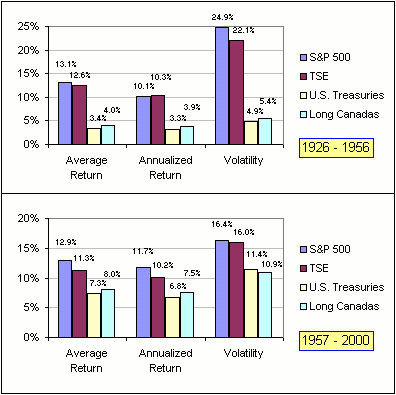| Correlation does it matter? |
Here's the problem.
We want to split our investments between two asset classes, A and B, say Large Cap and Small Cap stocks ...
>Or Growth and Value, or Equity and Income, or ...
Pay attention.
Assume the Average Annual Returns for each asset are a and b
where a 12.3% return means a = 0.123 and so on.
If a fraction x of our portfolio is devoted to asset A, and the balance,
1-x, is devoted to asset B, then G, the Mean Return for our portfolio will be
(1) G = a x + b (1-x)
>Assuming that you rebalance your portfolio every year, right?
Yes, in order to maintain the x and (1-x) fractions.
If the Standard Deviations for each asset are P and Q, respectively, then
SD, the Standard Deviation for our portfolio is given by:
(2) SD2 = P2 x2 + Q2 (1-x)2 + 2 x (1-x) R
>R? What's R?
That's the Covariance between the two assets, A and B.
>You're kidding. Am I supposed to know what ...?
Okay, pay attention. If the annual returns of asset A, over N years, are
a1, a2, a3 ... aN then, for this asset:
Mean Return =
a = (1/N)Σ an
(Standard Deviation)2 = P2 = (1/N)Σ (an - a)2
>And Σ means add them all up, right?
Right. Now, we're ready for the Covariance.
Covariance = R = (1/N)Σ (an - a)(bn - b)
>I assume that bn stands for the annual returns of asset B, right?
Right. Now, notice something interesting. Those things like (an - a)
and (bn - b) are the deviations from the average returns.
If the two assets were correlated, then when the first return is larger (or smaller)
than its average it's likely that the second return is larger (or smaller) than its average
and the product (an - a)(bn - b) is more likely to be positive so
adding all these terms is likely give a positive sum and ...
>I think you're trying to tell me that R is likely to be positive when ...
Yes, when the assets are correlated. However, when they are NOT correlated, it's likely to be ZERO, the
positive deviations cancelling with the negative.
|
>A picture is worth a thousand ...
It assumes that asset A has a Mean Return a = 8% >A mix of each is better than either, right? | 
|
>But I'm more interested in the Annualized Return, not the Standard Deviation.
Okay, let's use the following approximation for AR the Annualized Portfolio Return
(see Average vs Annualized),
namely
AR = G - SD2/2 in terms of G, the Mean Portfolio Return, and
SD, the Portfolio Standard Deviation:
(3) AR = a x + b (1-x) - (1/2){ P2 x2 + Q2 (1-x)2 + 2 x (1-x) R }
|
>A picture is worth a thousand ...
Here it's again assumed that asset A has a Mean Return a = 8% >So a combination is again better than either, eh? | 
|
>More of asset B is we want a bigger gain ...
Because asset B has the larger Mean Return.
>But a mix is still better than either.
Remember we're still talking no correlation.
>So start talking about correlation!
Okay.
|
Here's a set of Portfolio stuff where we assume a Correlation Coefficient from
r = -1.0 (meaning when one return goes up, the other goes down, in perfect synchronism) to r = +1.0 (meaning when one return goes up, the other goes up as well). | 
|
>I thought we were talking about Covariance and now you talk about ...
The Pearson Correlation Coefficient, r, is related to the
Covariance like so:
| Covariance = r P Q |
(See Pearson Correlation Coefficient.)
Here's some interesting pictures with correlation, where (as before),
asset A has a Mean Return
a = 8%
and a Standard Deviation P = 20% and
asset B has Mean b = 15% and Standard Deviation Q = 35%:




>Mamma mia! The Minimum Volatility goes up and Maximum Annualized Return goes down!
You said it.
>I assume you have a magic formula for getting the Maximum Annualized Return.
Yes, it's like so:
|
Maximum Annualized Return (approximately), obtained for : x = (1/2) + (1/2) { Q2 - P2 + 2(a - b) } / { P2 + Q2 - 2r P Q }
where |
>Approximately? Why approximately?
We're using that approximate expression for Annualized Return, formula (3), remember?
Besides, parameters like Mean Return and Standard Deviation are based upon historical data and
we can't ...
>Yeah, yeah, I know. The past is no guarantee of the future.
You're getting smarter.
>Well ... that's a terrible formula.
Okay, use this handy dandy calculator to get the "Optimal" parameters (yielding the largest Annualized Return).
The Annualized Returns displayed below actually use a somewhat different approximation
(noted here), namely:
(1+Annualized_Return)2 = (1+Mean_Return)2 - Standard_Deviation2:
>Yeah, but I haven't the faintest idea of what's a reasonable value for that Pearson Correlation Coefficient.
Look! Here's a bunch of values for the total U.S. stock market and other asset classes:

And then there's this:

and this correlation between some sectors (using 1950-2000 data):

>You're haven't talked about bonds or U.S. vs Canada or ....

See also Correlations and Pseudo-periodicity

